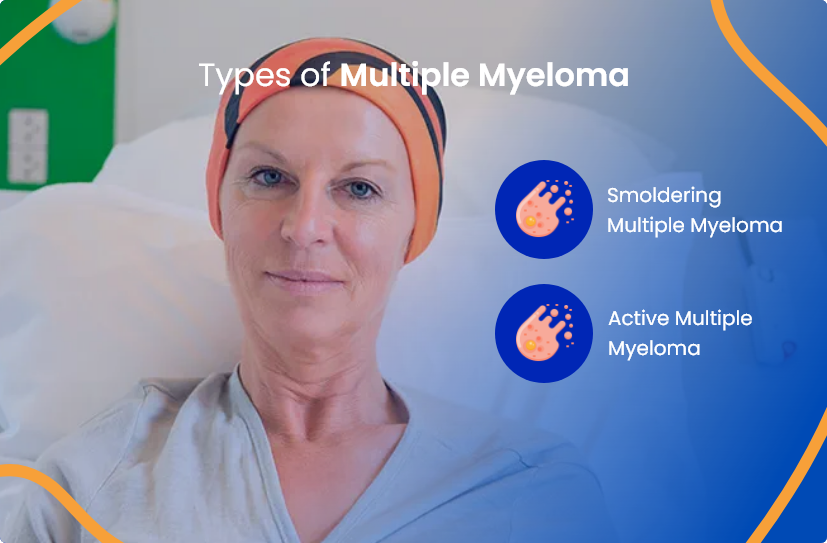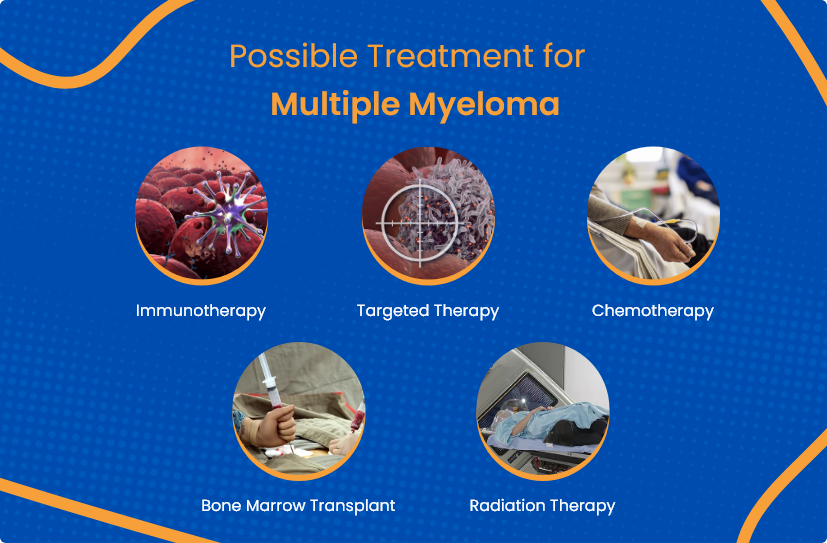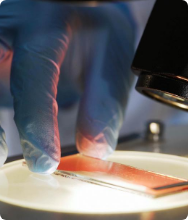
Book a Consultation
Thank you!
Your form has been sent successfully.

Cancer occurring in the plasma cells is called multiple myeloma. Healthy plasma cells, found in bone marrow, play a major role in fighting infections. In multiple myeloma, the bone marrow gets filled with cancerous plasma cells that replace the healthy blood cells. Instead of producing useful antibodies, the cancer cells create abnormal proteins that can be harmful to one's health. Compared to other types of blood cancers, multiple myeloma is relatively uncommon. In the US, multiple myeloma affects 1 in 132 people on a lifetime basis (0.76%).

Also known as asymptomatic myeloma, smoldering multiple myeloma displays a larger M protein in the blood or a higher number of myeloma plasma cells in the bone marrow compared to Monoclonal Gammopathy of Undetermined Significance (MGUS). The latter is another type of multiple myeloma in which M protein is created by abnormal plasma cells but does not show any symptoms. The progression of smoldering myeloma is slow. Conducting a PET-CT scan or an MRI is crucial to determine the presence of bone disease. Smoldering multiple myeloma does not harm the body and neither shows the signs and symptoms typical of myeloma.
Active multiple myeloma patients have M-protein in their blood or urine. The bone marrow has 60% or more cancer cells. Symptoms may include kidney failure, anemia, high blood calcium, weak bones, and a muscle or soft tissue tumor containing myeloma cells.
The symptoms of multiple myeloma are:
 Fatigue
Fatigue
 Constipation
Constipation
 Nausea
Nausea
 Loss of appetite
Loss of appetite
 Weight loss
Weight loss
 Weakness in the legs
Weakness in the legs
 Pain in spine or chest
Pain in spine or chest

This therapy strengthens the patient’s natural immune system to fight cancer. It is also known as biological response modifier (BRM) or biologic therapy since it fights the disease with living organisms. The treatment is highly effective as it targets the cancer cells precisely without damaging the healthy cells.
It works by targeting the proteins, genes, and other substances that contribute to the growth and existence of cancer cells. Targeted therapy has proven its efficacy in treating multiple myeloma and enhancing prognosis. It alters proteins inside the cancer cells and destroys them. Moreover, the treatment also boosts the patient’s immunity to fight cancer.
In this treatment, drugs are administered to kill cancer cells. These drugs work by stopping the cancer cells from multiplying. There are multiple benefits of chemotherapy that make it one of the most effective multiple myeloma treatments. These benefits include:
Also known as stem cell transplant, the procedure involves replacing cancer-affected bone marrow with healthy cells. As a result, the body can generate red blood cells, white blood cells, and platelets. The cells used for bone marrow transplantation can come from the patient’s body or a donor.
This treatment procedure uses high-powered x-rays and protons to kill cancer cells or destroy their DNA to reduce their growth. Radiation therapy can shrink myeloma cells in a particular area quickly if it is affecting a bone or causing pain. It is prescribed if chemotherapy isn’t enough to alleviate the pain or other symptoms, in order to provide effective relief.
Diagnosis of multiple myeloma can be made via different procedures. These are:

Blood tests are done to check the levels of calcium, creatinine, albumin, and other electrolytes in the blood. Creatinine levels indicate if the kidneys are functioning correctly. If the creatinine level is high, it implies the kidneys are not functioning appropriately which is common in patients with multiple myeloma. An increase in the calcium levels can result in weakness, confusion, and fatigue. A blood test can also reveal the M proteins produced by myeloma cells. It helps to determine the extent of the disease, as well as how well treatment is working.

The use of an imaging test is crucial when multiple myeloma is suspected. In an imaging test like an X-ray, MRI, or CT scan, high-resolution images help determine the extent to which multiple myeloma has damaged the bones.

Biopsies and aspirations are used to check the bone marrow. The bone marrow tissue is extracted and evaluated to know the vital factors like size, appearance, and shape of the cells. Also, the arrangement of the cells and if the bone marrow has myeloma cells and the precise number of the myeloma cells present.
The specialists for multiple myeloma at ACTC in Florida, offer outstanding patient care by prescribing personalized and evidence-based treatment plans tailored to individual patients' needs. We aim to foster a positive environment that focuses on physical and mental health throughout a cancer patient's journey.
The following are our providers who you can consult at ACTC:

MD, Hematology & Oncology

MD, Ph.D., Hematology/ Medical Oncology

MD, Radiation Oncologist

As one of Florida's multiple myeloma treatment centers, we understand how a cancer diagnosis and treatment impact a person's physical and emotional well-being. Therefore, we work hard to make patients with all forms of cancer and their families feel secure. We provide comprehensive treatment for carcinoid tumors at ACTC, including screening, diagnosis, staging, treatment, and long-term follow-up in one convenient location.
Schedule a consultation by calling
 352-345-4565
352-345-4565
Multiple myeloma shows symptoms only when it has reached an advanced stage. Occasionally, multiple myeloma is detected early in case a routine blood test shows abnormally high protein levels.
Multiple myeloma treatment can often relieve symptoms and improve quality of life. It is important to opt for treatment as soon as the patient experiences symptoms from a reputable oncologist.
There are many factors that lead to myeloma. These include exposure to toxic chemicals, atomic radiation, immune system interference, and cancer-causing viruses.
Schedule a consultation by calling
 352-345-4565
352-345-4565